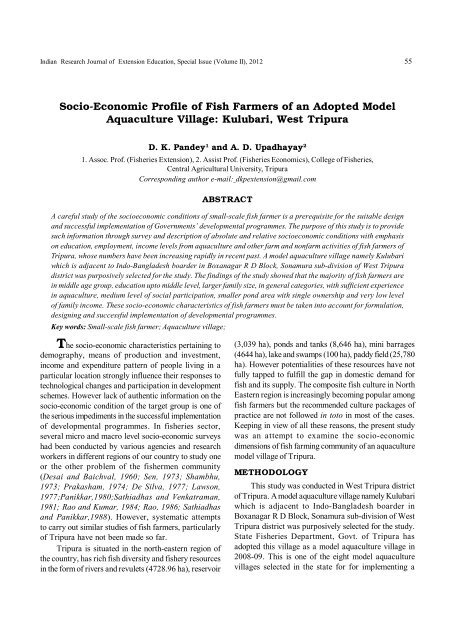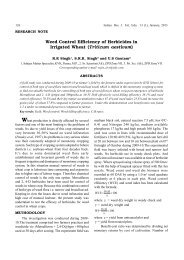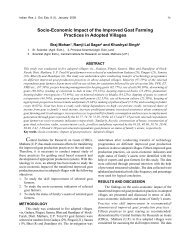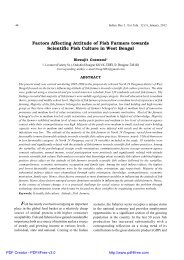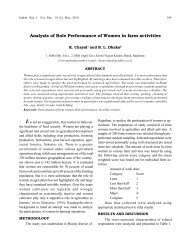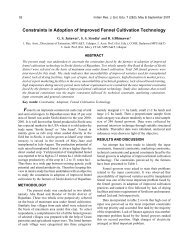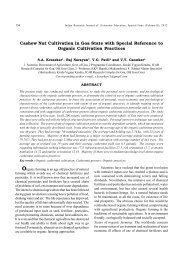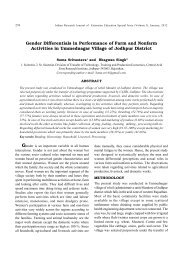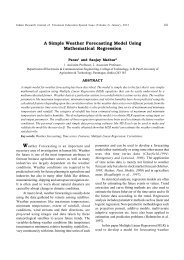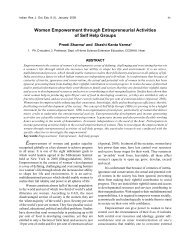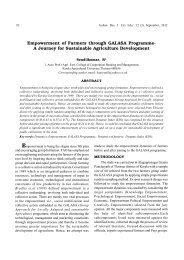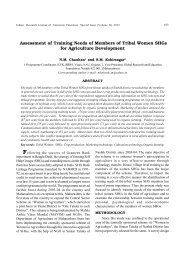Socio-Economic Profile of Fish Farmers of an Adopted ... - Seea.org.in
Socio-Economic Profile of Fish Farmers of an Adopted ... - Seea.org.in
Socio-Economic Profile of Fish Farmers of an Adopted ... - Seea.org.in
Create successful ePaper yourself
Turn your PDF publications into a flip-book with our unique Google optimized e-Paper software.
Indi<strong>an</strong> Research Journal <strong>of</strong> Extension Education, Special Issue (Volume II), 2012 55<strong>Socio</strong>-<strong>Economic</strong> <strong>Pr<strong>of</strong>ile</strong> <strong>of</strong> <strong>Fish</strong> <strong>Farmers</strong> <strong>of</strong> <strong>an</strong> <strong>Adopted</strong> ModelAquaculture Village: Kulubari, West TripuraD. K. P<strong>an</strong>dey 1 <strong>an</strong>d A. D. Upadhayay 21. Assoc. Pr<strong>of</strong>. (<strong>Fish</strong>eries Extension), 2. Assist Pr<strong>of</strong>. (<strong>Fish</strong>eries <strong>Economic</strong>s), College <strong>of</strong> <strong>Fish</strong>eries,Central Agricultural University, TripuraCorrespond<strong>in</strong>g author e-mail: dkpextension@gmail.comABSTRACTA careful study <strong>of</strong> the socioeconomic conditions <strong>of</strong> small-scale fish farmer is a prerequisite for the suitable design<strong>an</strong>d successful implementation <strong>of</strong> Governments’ developmental programmes. The purpose <strong>of</strong> this study is to providesuch <strong>in</strong>formation through survey <strong>an</strong>d description <strong>of</strong> absolute <strong>an</strong>d relative socioeconomic conditions with emphasison education, employment, <strong>in</strong>come levels from aquaculture <strong>an</strong>d other farm <strong>an</strong>d nonfarm activities <strong>of</strong> fish farmers <strong>of</strong>Tripura, whose numbers have been <strong>in</strong>creas<strong>in</strong>g rapidly <strong>in</strong> recent past. A model aquaculture village namely Kulubariwhich is adjacent to Indo-B<strong>an</strong>gladesh boarder <strong>in</strong> Box<strong>an</strong>agar R D Block, Sonamura sub-division <strong>of</strong> West Tripuradistrict was purposively selected for the study. The f<strong>in</strong>d<strong>in</strong>gs <strong>of</strong> the study showed that the majority <strong>of</strong> fish farmers are<strong>in</strong> middle age group, education upto middle level, larger family size, <strong>in</strong> general categories, with sufficient experience<strong>in</strong> aquaculture, medium level <strong>of</strong> social participation, smaller pond area with s<strong>in</strong>gle ownership <strong>an</strong>d very low level<strong>of</strong> family <strong>in</strong>come. These socio-economic characteristics <strong>of</strong> fish farmers must be taken <strong>in</strong>to account for formulation,design<strong>in</strong>g <strong>an</strong>d successful implementation <strong>of</strong> developmental programmes.Key words: Small-scale fish farmer; Aquaculture village;The socio-economic characteristics perta<strong>in</strong><strong>in</strong>g todemography, me<strong>an</strong>s <strong>of</strong> production <strong>an</strong>d <strong>in</strong>vestment,<strong>in</strong>come <strong>an</strong>d expenditure pattern <strong>of</strong> people liv<strong>in</strong>g <strong>in</strong> aparticular location strongly <strong>in</strong>fluence their responses totechnological ch<strong>an</strong>ges <strong>an</strong>d participation <strong>in</strong> developmentschemes. However lack <strong>of</strong> authentic <strong>in</strong>formation on thesocio-economic condition <strong>of</strong> the target group is one <strong>of</strong>the serious impediments <strong>in</strong> the successful implementation<strong>of</strong> developmental programmes. In fisheries sector,several micro <strong>an</strong>d macro level socio-economic surveyshad been conducted by various agencies <strong>an</strong>d researchworkers <strong>in</strong> different regions <strong>of</strong> our country to study oneor the other problem <strong>of</strong> the fishermen community(Desai <strong>an</strong>d Baichval, 1960; Sen, 1973; Shambhu,1973; Prakasham, 1974; De Silva, 1977; Lawson,1977;P<strong>an</strong>ikkar,1980;Sathiadhas <strong>an</strong>d Venkatram<strong>an</strong>,1981; Rao <strong>an</strong>d Kumar, 1984; Rao, 1986; Sathiadhas<strong>an</strong>d P<strong>an</strong>ikkar,1988). However, systematic attemptsto carry out similar studies <strong>of</strong> fish farmers, particularly<strong>of</strong> Tripura have not been made so far.Tripura is situated <strong>in</strong> the north-eastern region <strong>of</strong>the country, has rich fish diversity <strong>an</strong>d fishery resources<strong>in</strong> the form <strong>of</strong> rivers <strong>an</strong>d revulets (4728.96 ha), reservoir(3,039 ha), ponds <strong>an</strong>d t<strong>an</strong>ks (8,646 ha), m<strong>in</strong>i barrages(4644 ha), lake <strong>an</strong>d swamps (100 ha), paddy field (25,780ha). However potentialities <strong>of</strong> these resources have notfully tapped to fulfill the gap <strong>in</strong> domestic dem<strong>an</strong>d forfish <strong>an</strong>d its supply. The composite fish culture <strong>in</strong> NorthEastern region is <strong>in</strong>creas<strong>in</strong>gly becom<strong>in</strong>g popular amongfish farmers but the recommended culture packages <strong>of</strong>practice are not followed <strong>in</strong> toto <strong>in</strong> most <strong>of</strong> the cases.Keep<strong>in</strong>g <strong>in</strong> view <strong>of</strong> all these reasons, the present studywas <strong>an</strong> attempt to exam<strong>in</strong>e the socio-economicdimensions <strong>of</strong> fish farm<strong>in</strong>g community <strong>of</strong> <strong>an</strong> aquaculturemodel village <strong>of</strong> Tripura.METHODOLOGYThis study was conducted <strong>in</strong> West Tripura district<strong>of</strong> Tripura. A model aquaculture village namely Kulubariwhich is adjacent to Indo-B<strong>an</strong>gladesh boarder <strong>in</strong>Box<strong>an</strong>agar R D Block, Sonamura sub-division <strong>of</strong> WestTripura district was purposively selected for the study.State <strong>Fish</strong>eries Department, Govt. <strong>of</strong> Tripura hasadopted this village as a model aquaculture village <strong>in</strong>2008-09. This is one <strong>of</strong> the eight model aquaculturevillages selected <strong>in</strong> the state for for implement<strong>in</strong>g a
Indi<strong>an</strong> Research Journal <strong>of</strong> Extension Education, Special Issue (Volume II), 2012 57Family size <strong>an</strong>d caste: An <strong>an</strong>alysis <strong>of</strong> the data revealsthat the majority <strong>of</strong> the respondents (70 %) <strong>of</strong> the modelvillage had larger family size i.e. more th<strong>an</strong> fivemembers. 25 per cent <strong>of</strong> the respondents had mediumsize <strong>of</strong> family consist<strong>in</strong>g <strong>of</strong> three to five members. Only5% <strong>of</strong> the respondents had small size <strong>of</strong> family (up tothree members). This shows that the majority <strong>of</strong> fishfarmers have to ma<strong>in</strong>ta<strong>in</strong> the livelihood <strong>of</strong> more th<strong>an</strong>five members with available resources <strong>an</strong>dopportunities. The religion pattern <strong>of</strong> the respondentsshows that the majority (85per cent) <strong>of</strong> them arereligious m<strong>in</strong>ority (Muslim). Majority <strong>of</strong> therespondents <strong>of</strong> the model village (82.50 per cent) belongsto general caste category followed by 20 per centscheduled tribes (ST), 17 per cent other backwardcommunities (OBC) <strong>an</strong>d 15 per cent <strong>of</strong> scheduled castes(SC). The size <strong>of</strong> the family has a direct <strong>in</strong>fluence onthe expenditure <strong>an</strong>d <strong>in</strong>come patterns <strong>of</strong> the family. Asthe fish production is a labour <strong>in</strong>tensive activity hencefamily size <strong>in</strong>fluences the fish production.Experience <strong>in</strong> Aquaculture: It is almost establishedfact that the experiences <strong>of</strong> farmers <strong>in</strong> aquaculture havepositive <strong>in</strong>fluence on fish production. In the study area47.50 per cent <strong>of</strong> the respondents hav<strong>in</strong>g experience <strong>in</strong>composite fish culture i.e., above 10 years, while 30per cent <strong>of</strong> the respondents had experience <strong>of</strong> 5-10years(fig-2). Rema<strong>in</strong><strong>in</strong>g 22.50 percent respondents hadlow level <strong>of</strong> experience (1ha) size <strong>of</strong> pond respectively. This is clear <strong>in</strong>dicative<strong>of</strong> smaller size <strong>of</strong> pond available with farmers <strong>of</strong> Tripura.Further this result also <strong>in</strong>dicates skewed distribution <strong>of</strong>resources <strong>in</strong> terms <strong>of</strong> pond area across the fish farm<strong>in</strong>gcommunity.Nature <strong>of</strong> ownership <strong>of</strong> pond: The m<strong>an</strong>y m<strong>an</strong>agementdecisions related to fish farm<strong>in</strong>g are <strong>in</strong>fluenced by type<strong>of</strong> ownership <strong>in</strong>volved. In the study area it was foundthat 80% farmers were do<strong>in</strong>g aquaculture on their ownpond with s<strong>in</strong>gle ownership where as <strong>in</strong> 20% casesfarmers were tak<strong>in</strong>g fish production <strong>in</strong> jo<strong>in</strong>tly ownedponds (Fig-3).Total family <strong>in</strong>come: In general, employment <strong>an</strong>d<strong>in</strong>come are the tw<strong>in</strong> decisive factors determ<strong>in</strong><strong>in</strong>g thest<strong>an</strong>dard <strong>of</strong> liv<strong>in</strong>g <strong>of</strong> people <strong>in</strong> the community or region.Equitable distribution <strong>of</strong> <strong>in</strong>come across the societyfurther enh<strong>an</strong>ces the social harmony among differentsections <strong>of</strong> population. Analysis <strong>of</strong> <strong>in</strong>come levels <strong>of</strong> thefish farmer <strong>in</strong> model village has brought out some<strong>in</strong>terest<strong>in</strong>g features. The classification <strong>of</strong> fish farmerfamilies based on <strong>in</strong>come level is given <strong>in</strong> Table 1. The
58 Indi<strong>an</strong> Research Journal <strong>of</strong> Extension Education, Special Issue (Volume II), 2012majority <strong>of</strong> the respondents, i.e., 77.50 per cent hadmonthly <strong>in</strong>come level above Rs 3, 000, whereas 12.50per cent had <strong>in</strong>come level Rs 2,000-3,000. Only 7.50per cent fish farmers had monthly <strong>in</strong>come <strong>of</strong> Rs 1,000-2000. This low level <strong>of</strong> <strong>in</strong>come reflects <strong>in</strong> their pooreconomic condition, which was not sufficient to ma<strong>in</strong>ta<strong>in</strong>their normal livelihood. They c<strong>an</strong>not afford much forfish culture activities. Total family expenditure pattern<strong>in</strong> most <strong>of</strong> the fish farmers were <strong>in</strong> the low-<strong>in</strong>comegroup <strong>an</strong>d found it difficult to meet even theirconsumption requirements from their earn<strong>in</strong>gs.CONCLUSIONThe development <strong>of</strong> aquaculture may be beneficialprovided socioeconomic aspects receive due attention<strong>in</strong> pl<strong>an</strong>n<strong>in</strong>g the promotion <strong>of</strong> aquaculture. The abovediscussed results give <strong>an</strong> idea about socio-economicstatus <strong>of</strong> fish farmers <strong>of</strong> the study area. The majority <strong>of</strong>fish farmers are <strong>in</strong> middle age group, education up tomiddle level, larger family size, <strong>in</strong> general categories,with sufficient experience <strong>in</strong> aquaculture, medium level<strong>of</strong> social participation, smaller pond area with s<strong>in</strong>gleownership <strong>an</strong>d very low level <strong>of</strong> family <strong>in</strong>come. Thesesocio-economic characteristics <strong>of</strong> fish farmers must betaken <strong>in</strong>to account for formulation, design<strong>in</strong>g <strong>an</strong>dsuccessful implementation <strong>of</strong> developmentalprogrammes.REFERENCESP<strong>an</strong>ikkar, K. K. P., 1980. Coastal rural <strong>in</strong>debtedness -Acase study. Mar.<strong>Fish</strong>. In format. Servo T&E Ser., 18: 1-12.Prakasham, M. S., 1974. Impact <strong>of</strong> mech<strong>an</strong>isation <strong>of</strong> fishermen. Voluntary Action, 16 (2&3): 13-19.Rao, D. L. P. <strong>an</strong>d Kumar, R. Y., 1984. Impact <strong>of</strong> mech<strong>an</strong>ization on a traditional economy: A case study <strong>of</strong> fishermen <strong>in</strong>Vishakhapatnam, M<strong>an</strong> Life, 10(1&2): 31-42.Rao, N. S., 1986. <strong>Economic</strong>s <strong>of</strong> <strong>Fish</strong>eries: A Case Study <strong>of</strong> Andhra Pradesh. Daya Publish<strong>in</strong>g House, Delhi, 160 pp.Sathiadhas, R. <strong>an</strong>d P<strong>an</strong>ikkar, K. K., 1988. <strong>Socio</strong>-economics <strong>of</strong> small scale fishermen with emphasis on costs <strong>an</strong>d earn<strong>in</strong>gs <strong>of</strong>traditional fish<strong>in</strong>g units along Triv<strong>an</strong>drum coast, Kerala – A case study, Sea Food Export J., 20(2): 21-36.Sathiadhas, R. <strong>an</strong>d Venkatram<strong>an</strong>, G., 1981. Impact <strong>of</strong> mech<strong>an</strong>ized fish<strong>in</strong>g on the socio-economic conditions <strong>of</strong> the fishermen <strong>of</strong>Sakthikul<strong>an</strong>gara- Neendakara, Kerala. Mar. <strong>Fish</strong>.Informat. Servo T&E Ser., 38: 17-19.Sen, A., 1973. Poverty, <strong>in</strong>equality <strong>an</strong>d unemployment - some conceptual issues <strong>in</strong> measurement. <strong>Economic</strong> <strong>an</strong>d PoliticalWeekly, 16 (4): 1950.Shambhu D., 1973. Projections for dem<strong>an</strong>d <strong>of</strong> fish <strong>in</strong> India. Seafood Export J. 5 (4): 13-22.S<strong>in</strong>gh, R., 1983. Selected characteristics <strong>of</strong> farmers <strong>in</strong> relation to their adoption <strong>of</strong> farm mech<strong>an</strong>ization. Indi<strong>an</strong> J. Ext Edu.,19: 11-17.


